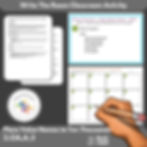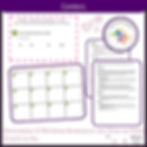Writing organization is a foundational skill that greatly influences students' overall writing quality and coherence. For students in special education, achieving proficiency in organizing their writing can be particularly challenging. However, with well-defined IEP goals and targeted instructional strategies, these students can make significant progress. This blog post outlines various IEP goals and practical methods to enhance writing organization skills in special education settings.
What You Will Learn
Learn how to set effective IEP goals and apply instructional strategies to improve writing organization for students with special needs.
IEP Goals for Writing Organization
Addressing Audience and Purpose
Sarah, a fifth-grader, struggled with structuring her essays logically. By incorporating sequencing activities and audience-targeted prompts, her teacher observed a noticeable improvement in her writing coherence. Sarah was able to logically order her thoughts and tailor her writing to her intended readers, achieving her IEP objectives consistently.
IEP Goal: By (date), Sarah will organize writing to address audience and purpose in chronological and logical sequences, improving organizational skills from [current level] to [target level] as measured by [assessment method].
Objectives:
Sarah will sequence writing logically in 8/10 trials.
Sarah will address the audience appropriately in her writing in 8/10 trials.
Sarah will revise writing to improve organization and coherence in 8/10 trials.
Connecting Related Ideas
Liam, a fourth-grader, had difficulty linking ideas in his sentences. His teacher introduced conjunction games and sentence combining exercises, which helped Liam understand how to connect related thoughts. Over time, Liam's writing markedly improved coherence and flow, meeting his IEP goals.
IEP Goal: By (date), Liam will write sentences which connect related ideas, improving sentence structure from [current level] to [target level] as measured by [assessment method].
Objectives:
Liam will write connected sentences on a topic in 8/10 trials.
Liam will use conjunctions to link related ideas in 8/10 trials.
Liam will revise sentences to improve coherence in 8/10 trials.
Developing and Supporting Topics
Emma, a sixth-grader, struggled with finding and using reliable sources for her research assignments. By using a structured approach and introducing her to trusted online databases and library resources, Emma improved her ability to gather and present accurate information.
IEP Goal: By (date), Emma will research using verifiable sources to develop and support a topic, improving research skills from [current level] to [target level] as measured by analysis of research assignments.
Objectives:
Emma will use at least three reliable sources for research assignments in 8/10 trials.
Emma will correctly cite sources in her research in 8/10 trials.
Emma will present her research findings coherently in 8/10 trials.
Narrative Writing Structure
Noah, a third-grader, had difficulty structuring his stories with a clear beginning, middle, and end. By using graphic organizers and story maps, Noah's teacher helped him understand how to build a cohesive narrative.
IEP Goal: By (date), Noah will write stories with a beginning, middle, and end, improving narrative writing skills from [current level] to [target level] as measured by teacher evaluation.
Objectives:
Noah will use a graphic organizer to plan his stories in 8/10 trials.
Noah will write stories that include all three parts: beginning, middle, and end in 8/10 trials.
Noah will revise his stories to ensure they have a clear structure in 8/10 trials.
Using Transition Words
Ava, a fifth-grader, often wrote disjointed paragraphs. Her teacher introduced transition words through exercises and examples, helping Ava create smoother transitions between her ideas.
IEP Goal: By (date), Ava will demonstrate organization by developing a beginning, middle, and ending using some transition words (e.g., first, next, then), improving the flow of her writing from [current level] to [target level] as measured by analysis of writing samples.
Objectives:
Ava will use at least three transition words in her writing in 8/10 trials.
Ava will organize her writing with a clear beginning, middle, and end in 8/10 trials.
Ava will revise her writing to improve the use of transition words in 8/10 trials.
Clear Sequencing of Ideas
Ethan, a seventh-grader, had trouble maintaining clear sequencing in his essays. With the help of outlines and structured writing prompts, Ethan learned to organize his ideas more effectively.
IEP Goal: By (date), Ethan will demonstrate organization by developing an introduction, body of text, and conclusion with clear sequencing of ideas and use of transitional words and phrases, improving his essay structure from [current level] to [target level] as measured by analysis of writing samples.
Objectives:
Ethan will create an outline before writing essays in 8/10 trials.
Ethan will use transitional phrases to connect paragraphs in 8/10 trials.
Ethan will revise his essays to ensure clear sequencing in 8/10 trials.
Organizational Strategies
Mia, an eighth-grader, struggled with organizing her research papers. Through instruction on various organizational strategies, such as outlining and mapping, Mia improved her ability to structure her papers logically.
IEP Goal: By (date), Mia will select appropriate organizational strategies (e.g., outlining, identifying, and supporting topics, following a model, maps, and charts), improving her research paper organization from [current level] to [target level] as measured by teacher evaluation.
Objectives:
Mia will create an outline for her research papers in 8/10 trials.
Mia will use mapping techniques to organize her ideas in 8/10 trials.
Mia will follow organizational models to structure her papers in 8/10 trials.
Paragraph Organization
Lucas, a fifth-grader, often wrote single long paragraphs without proper breaks. Through paragraph-writing exercises, he learned to organize his writing into clear, distinct paragraphs.
IEP Goal: By (date), Lucas will organize writing with paragraphs when writing from a prompt or on a topic, improving his paragraph structure from [current level] to [target level] as measured by analysis of writing samples.
Objectives:
Lucas will write at least three distinct paragraphs in response to prompts in 8/10 trials.
Lucas will use topic sentences to begin paragraphs in 8/10 trials.
Lucas will revise his writing to ensure proper paragraph breaks in 8/10 trials.
Structured Paragraphs
Olivia, a sixth-grader, struggled with writing paragraphs that focused on a single topic. With the help of targeted exercises, Olivia learned to write clear and focused paragraphs.
IEP Goal: By (date), Olivia will use paragraphs to organize structure within text for a specific purpose or content, improving paragraph coherence from [current level] to [target level] as measured by teacher evaluation.
Objectives:
Olivia will write paragraphs that focus on a single topic in 8/10 trials.
Olivia will include supporting details within each paragraph in 8/10 trials.
Olivia will revise her paragraphs to improve focus and coherence in 8/10 trials.
Paragraph Unity
Jack, a fourth-grader, often included unrelated sentences within his paragraphs. Through practice and feedback, Jack learned to maintain unity in his paragraphs.
IEP Goal: By (date), Jack will write paragraphs in which sentences are related to the topic, improving paragraph unity from [current level] to [target level] as measured by analysis of writing samples.
Objectives:
Jack will write paragraphs where all sentences are related to the main topic in 8/10 trials.
Jack will use topic and concluding sentences effectively in 8/10 trials.
Jack will revise paragraphs to ensure sentence relevance in 8/10 trials.
Main Idea and Closing Sentences
Isabella, a fifth-grader, struggled with writing paragraphs that had clear main ideas and closing sentences. With targeted instruction, she improved her ability to construct well-defined paragraphs.
IEP Goal: By (date), Isabella will write paragraphs containing a stated main idea and closing sentence, improving her paragraph structure from [current level] to [target level] as measured by teacher evaluation.
Objectives:
Isabella will write paragraphs with a clear main idea in 8/10 trials.
Isabella will include a closing sentence in her paragraphs in 8/10 trials.
Isabella will revise her paragraphs to ensure they have a clear main idea and conclusion in 8/10 trials.
Multi-Paragraph Writing
David, a seventh-grader, had difficulty expanding his writing into multi-paragraph essays. Through structured writing assignments, he learned to develop his ideas across multiple paragraphs.
IEP Goal: By (date), David will write multi-paragraph passages (e.g., stories, reports), improving his essay writing from [current level] to [target level] as measured by analysis of writing samples.
Objectives:
David will plan multi-paragraph essays using outlines in 8/10 trials.
David will write at least three paragraphs for each assigned essay in 8/10 trials.
David will revise his essays to ensure they have a clear multi-paragraph structure in 8/10 trials.
Text Revision
Sophia, a sixth-grader, often wrote essays that lacked clarity. Through revision exercises, she learned to add or delete text to improve her writing.
IEP Goal: By (date), Sophia will revise writing by adding or deleting text, improving writing clarity from [current level] to [target level] as measured by teacher evaluation.
Objectives:
Sophia will identify areas to add details in her writing in 8/10 trials.
Sophia will remove unnecessary information to improve clarity in 8/10 trials.
Sophia will revise her writing to ensure clarity and coherence in 8/10 trials.
Improving Clarity
Michael, a seventh-grader, had trouble with clarity in his writing. Through targeted revision exercises, Michael learned to improve the clarity of his essays.
IEP Goal: By (date), Michael will change some text to improve clarity, improving his writing from [current level] to [target level] as measured by teacher evaluation.
Objectives:
Michael will revise sentences for clarity in 8/10 trials.
Michael will reorganize paragraphs to improve clarity in 8/10 trials.
Michael will seek feedback and revise his writing based on suggestions in 8/10 trials.
Enhancing Writing Effectiveness
Charlotte, a fifth-grader, struggled with making her writing clear and effective. Through practice and feedback, she learned to revise her writing to add relevant details and improve clarity.
IEP Goal: By (date), Charlotte will revise writing to improve clarity and effectiveness by adding relevant details and changing or rearranging text, improving her writing skills from [current level] to [target level] as measured by teacher evaluation.
Objectives:
Charlotte will add relevant details to her writing in 8/10 trials.
Charlotte will rearrange sentences to improve coherence in 8/10 trials.
Charlotte will revise her writing to enhance overall clarity and effectiveness in 8/10 trials.
Organizing Sentences into Paragraphs
James, a sixth-grader, often wrote essays with poorly organized sentences. Through targeted exercises, James learned to organize his sentences into well-structured paragraphs.
IEP Goal: By (date), James will edit writing to organize sentences into paragraphs, improving his essay structure from [current level] to [target level] as measured by teacher evaluation.
Objectives:
James will identify logical breaks for paragraphs in his writing in 8/10 trials.
James will group related sentences into paragraphs in 8/10 trials.
James will revise his writing to ensure sentences are well-organized into paragraphs in 8/10 trials.
Using Transitional Words and Phrases
Chloe, a seventh-grader, struggled with using transitional words to connect ideas in her writing. Through targeted instruction, she learned to use transitions effectively.
IEP Goal: By (date), Chloe will edit writing to use transitional words and phrases to connect ideas in sentences and paragraphs (e.g., therefore, on the other hand), improving writing flow from [current level] to [target level] as measured by teacher evaluation.
Objectives:
Chloe will use at least three transitional words in her writing in 8/10 trials.
Chloe will connect ideas within and between paragraphs using transitions in 8/10 trials.
Chloe will revise her writing to improve the use of transitional words and phrases in 8/10 trials.
Sequencing Writing
Jackson, a fifth-grader, often wrote stories that lacked clear sequence. Through targeted sequencing activities, Jackson improved his ability to write stories with a logical sequence.
IEP Goal: By (date), Jackson will revise writing so it has a sequence (e.g., beginning, middle, end), improving narrative coherence from [current level] to [target level] as measured by teacher evaluation.
Objectives:
Jackson will use story maps to plan sequences in his writing in 8/10 trials.
Jackson will write stories with a clear sequence in 8/10 trials.
Jackson will revise his writing to ensure logical sequence in 8/10 trials.
Organizing Writing
Grace, a seventh-grader, had trouble with organizing her essays. Through targeted exercises, Grace learned to organize her writing so it has an order that makes sense, including details, ideas, sentences, time sequence, and paragraphs.
IEP Goal: By (date), Grace will revise writing so the paper has an order that makes sense, including details, ideas, sentences, time sequence, and paragraphs, improving writing organization from [current level] to [target level] as measured by teacher evaluation.
Objectives:
Grace will create outlines before writing essays in 8/10 trials.
Grace will organize her writing with logical order in 8/10 trials.
Grace will revise her writing to ensure it follows a logical sequence and structure in 8/10 trials.
Classifying Words and Topics
Benjamin, a sixth-grader, struggled with classifying words and topics into organizational schemes. Through targeted vocabulary exercises, Benjamin learned to classify words and topics effectively.
IEP Goal: By (date), Benjamin will classify words and topics into organizational schemes, improving his vocabulary and organizational skills from [current level] to [target level] as measured by teacher evaluation.
Objectives:
Benjamin will use graphic organizers to classify words in 8/10 trials.
Benjamin will organize topics into categories in 8/10 trials.
Benjamin will revise his classifications to ensure accuracy in 8/10 trials.
Improving writing organization skills in special education students requires clear, achievable IEP goals and effective instructional strategies. By focusing on these goals and utilizing practical methods, teachers can support their students in becoming more organized and coherent writers.
Explore our IEP Goal Bank, Lesson Plan Templates, and TeachTastic Store for more resources and tools to support your teaching.

































